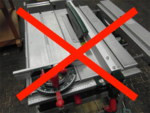Table Saw Introduction: Difference between revisions
From CoMakingSpace Wiki
updated 'practical demonstration' & manual link to Elektra Beckum PK 255; bit more about the riving knife |
m →Safety: blade guard should be 10 mm above workpiece |
||
| Line 25: | Line 25: | ||
** high blade: cuts "down", not pushing against you - makes the saw easier to use and leads to less of a difference between cut distances on top and bottom BUT it exposes a lot of the dangerous blade | ** high blade: cuts "down", not pushing against you - makes the saw easier to use and leads to less of a difference between cut distances on top and bottom BUT it exposes a lot of the dangerous blade | ||
** low blade: lower risk of serious injury (could cut into your finger, not as easily ''trough'' it) but you have to push the workpiece harder | ** low blade: lower risk of serious injury (could cut into your finger, not as easily ''trough'' it) but you have to push the workpiece harder | ||
* use the top blade guard whenever it is not hindering your cut - it should be fixed so its bottom edge is horizontal | * use the top blade guard whenever it is not hindering your cut - it should be fixed so its bottom edge is horizontal and at least 10 mm above the workpiece | ||
|- | |- | ||
| kickback - if the workpiece is pressed against the blade's side, it can be thrown towards the operator! | | kickback - if the workpiece is pressed against the blade's side, it can be thrown towards the operator! | ||
Revision as of 02:24, 28 September 2019
This is the content required for an introduction to our table saw - reading this does NOT replace the mandatory session with a tutor! It will make it a lot quicker though ;-)
Let's begin! First off, make sure you have read the machine's manual.
Safety
A dust mask may also be necessary depending on the material you are cutting!
- gloves: make an informed decision
- some sources say you should wear them to protect yourself against splinters which could surprise you and make your hand flinch in a dangerous position
- others prohibit the use of gloves, fearing your entire hand could be dragged into the blade if one gets caught
| Dangers | Precautions |
|---|---|
sharp and rotating exposed blade, with chances of flesh wounds and missing limbs
|
|
kickback - if the workpiece is pressed against the blade's side, it can be thrown towards the operator!
|

|
| sawdust and small splinters can fly towards the operator |
|
Practical Demonstration
- how to set up parallel fence, miter fence or crosscut sled
- safety switch - accessible by knee so you don't need to let go of your workpiece
- practice cut(s)

